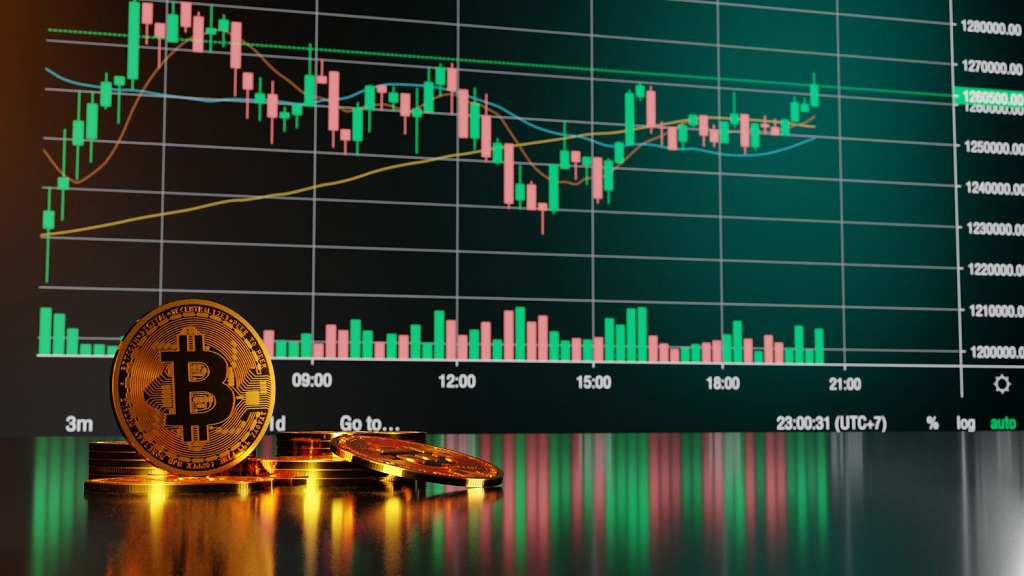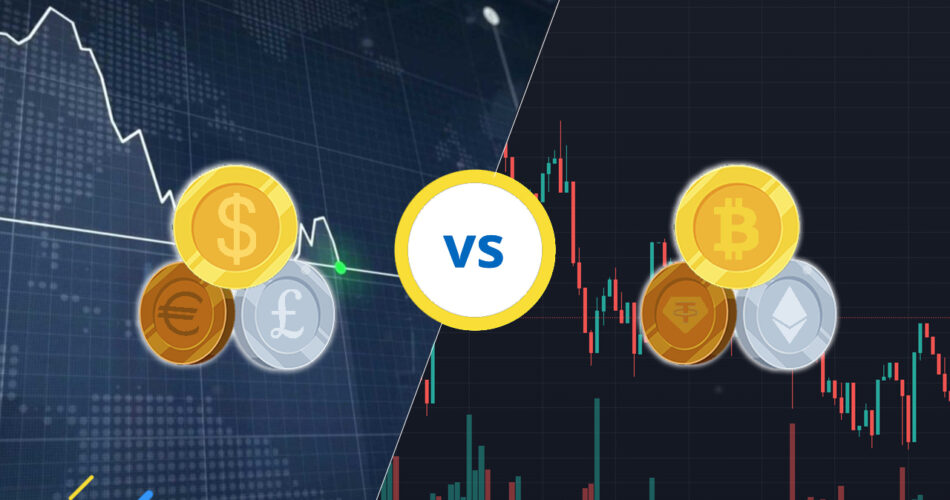In the dynamic world of digital trading, understanding the differences between Forex and Crypto trading is as crucial as knowing the rules of the game. This article will serve as your comprehensive guide, illuminating the intricacies of both trading forms and how they compare to each other in the Forex vs Crypto debate.
Table of Contents
Understanding Forex Trading

Forex Trading: A Brief History and Definition
Forex trading, or foreign exchange trading, is the process of buying and selling currencies on a global market. It’s a financial game of chess, where strategic moves can lead to significant gains or losses.
How Forex Trading Works
Forex trading operates much like a global marketplace. You choose a currency pair to trade, predicting whether one currency will strengthen or weaken against the other.
Key Advantages of Forex Trading
| Trading | Description | Example |
|---|---|---|
| Profiting from Rising and Falling Markets | Ability to make a profit whether the market is rising or falling | If you believe EUR will strengthen against USD, you can buy EUR/USD. If it weakens, you can sell EUR/USD |
| High Liquidity | High level of liquidity due to large market size | Transactions can be completed quickly and easily, with little impact on price |
| Influence of Macroeconomic Factors | Forex prices are heavily influenced by macroeconomic factors | Traders can use economic indicators and news events to predict Forex price movements |
| Availability of Leverage | Ability to control a large amount of money with a small initial deposit | With a leverage of 100:1, you can control $100,000 with a $1,000 deposit |
Risks Involved in Forex Trading
However, Forex trading isn’t without its risks. These risks include market volatility, leverage risks, and the risk of interest rate changes.
Understanding Crypto Trading

Crypto Trading: A Brief History and Definition
Crypto trading involves buying and selling digital currencies, such as Bitcoin. It’s a more advanced, digital form of exchange, often likened to the wild west of finance due to its volatility and unpredictability.
How Crypto Trading Works
Crypto trading works similarly to Forex trading, but instead of trading fiat currencies, you’re trading digital assets. It’s a digital marketplace where fortunes can be made and lost in the blink of an eye.
Key Advantages of Crypto Trading
| Advantages of Crypto Trading | Description | Example |
|---|---|---|
| Potential for High Returns | High volatility can lead to significant price swings | Bitcoin’s price increased from nearly $0 in 2009 to tens of thousands of dollars in 2021 |
| Market Accessibility | Crypto market operates 24/7 | You can trade cryptocurrencies at any time, from anywhere |
| Innovative Technology | Cryptocurrencies are based on blockchain technology | Blockchain technology is transparent, secure, and decentralized |
| Diversification | Cryptocurrencies offer a new asset class | Adding cryptocurrencies to a portfolio can help diversify and spread risk |
| Ownership | Direct ownership of the asset | When you buy a cryptocurrency, you own it outright without the need for a central authority |
Risks Involved in Crypto Trading
However, just like Forex trading, crypto trading also comes with risks. These include market volatility, regulatory changes, and security risks.
Forex vs Crypto: Key Differences
| Forex vs Crypto | Forex | Crypto |
|---|---|---|
| Market Size and Liquidity | Largest and most liquid market in the world | Smaller and less liquid market |
| Trading Hours | 24/5 | 24/7 |
| Volatility | Moderate | High |
| Regulatory Environment | Heavily regulated | Less regulated |
| Accessibility and Ease of Trading | Highly accessible, larger initial investment | Highly accessible, smaller initial investment |
Understanding the key differences between Forex and Crypto trading is crucial for any trader. These differences can significantly impact your trading strategy and potential returns. Let’s delve deeper into these differences.
Market Size and Liquidity
Forex is the largest and most liquid market in the world, with a daily trading volume exceeding $6 trillion. This high liquidity means that transactions can be completed quickly and easily, with little impact on price.
On the other hand, the crypto market is much smaller and less liquid. While it has grown rapidly in recent years, its daily trading volume is still only a fraction of the Forex market. This lower liquidity can lead to higher price volatility and potential slippage.
Trading Hours
Forex trading occurs 24 hours a day, five days a week. This is because there’s always at least one financial center in the world that’s open for business.
Crypto trading, however, occurs 24 hours a day, seven days a week. This is because cryptocurrencies are decentralized and not tied to any specific country or financial institution.
Volatility
While both markets are volatile, the crypto market is known for its extreme price swings. This high volatility can present both opportunities and risks for traders.
Forex markets, while still volatile, tend to be more stable than the crypto market. This is due to the larger size of the Forex market and the influence of central banks and economic indicators.
Regulatory Environment
The Forex market is heavily regulated by governmental and independent bodies around the world. These regulations are designed to protect traders and maintain the integrity of the market.
The crypto market, however, is less regulated. While some countries have implemented crypto regulations, others have banned cryptocurrencies altogether. This lack of consistent regulation can lead to increased risk.
Accessibility and Ease of Trading
Both Forex and crypto trading are highly accessible, with numerous online platforms available for traders. However, Forex trading typically requires a larger initial investment than crypto trading.
Forex vs Crypto: Similarities
Despite their differences, Forex and Crypto trading share several similarities. Understanding these similarities can help traders leverage their knowledge and experience in one market to succeed in the other.
Both are Forms of Currency Trading
At their core, both Forex and Crypto trading involve buying and selling currencies. In Forex trading, you’re dealing with fiat currencies like the US Dollar, Euro, or Japanese Yen. In Crypto trading, you’re dealing with digital currencies like Bitcoin, Ethereum, or Litecoin. The goal in both cases is to buy when the price is low and sell when the price is high.
Both Require Strategic Planning and Risk Management
Successful trading, whether it’s Forex or Crypto, requires a well-thought-out strategy. Traders need to understand market trends, analyze charts, and make informed decisions. Additionally, both forms of trading require effective risk management. This includes setting stop-loss orders to limit potential losses and knowing when to take profits.
Both Offer the Potential for Significant Profits
Both Forex and Crypto trading offer the potential for significant profits. In the Forex market, traders can leverage their positions to maximize potential profits. In the Crypto market, the high volatility can lead to large price swings, offering the potential for high returns.
However, it’s important to remember that the potential for high profits also comes with high risk. Therefore, traders should only invest money they can afford to lose.
Strategies for Forex and Crypto Trading

Successful trading in both Forex and Crypto markets requires a well-thought-out strategy. These strategies can help traders make informed decisions, manage their risk, and potentially increase their profits. Let’s delve into some common strategies for both Forex and Crypto trading.
Common Strategies for Forex Trading
- Trend Trading: This strategy involves identifying the market’s direction (upwards, downwards, or sideways) and making trades that align with this trend. Traders use technical analysis tools like moving averages to identify trends.
- Swing Trading: Swing traders aim to capture gains in a stock (or any financial instrument) within an overnight hold to several weeks. They utilize technical analysis to find stocks with short-term price momentum.
- Scalping: This is a strategy where traders aim to make profits from small price changes. It requires a strict exit strategy as a large loss could eliminate the many small gains achieved.
- Position Trading: This is a long-term strategy where traders hold positions for weeks, months, or even years. It’s based more on fundamental analysis than technical charts.
Common Strategies for Crypto Trading
- HODLing: This term comes from a misspelling of “hold” and involves buying and holding cryptocurrencies for long periods, regardless of market volatility.
- Day Trading: This strategy involves making multiple trades within a day to profit from short-term price movements. Day traders spend a lot of time staring at computer screens, and they usually only close all trades by the end of each day.
- Swing Trading: Similar to Forex, swing trading in crypto involves holding a position for a certain period, capturing price changes or “swings.”
- Automated Trading/Bots: Given the 24/7 operation of the crypto market, many traders use automated trading software or bots to trade cryptocurrencies. These bots can follow a set strategy based on technical analysis and execute trades on your behalf.
Choosing the Right Strategy
Choosing the right strategy depends on various factors, including your risk tolerance, time commitment, and trading goals. It’s crucial to understand each strategy’s risks and rewards and how it fits into your overall financial plan. Remember, no strategy guarantees success, and all involve risk. It’s essential to use risk management techniques and diversify your trading portfolio.
Choosing Between Forex and Crypto Trading
Choosing between Forex and Crypto trading is a significant decision that depends on various factors. These factors include your financial goals, risk tolerance, and the amount of time you can dedicate to trading. Let’s delve into these factors in more detail.
Understanding Your Financial Goals
Your financial goals play a crucial role in determining whether Forex or Crypto trading is right for you. If you’re looking for a more stable and regulated market with high liquidity, Forex might be the better choice. However, if you’re willing to take on more risk for the potential of higher returns and are interested in emerging technologies, Crypto trading could be more suitable.
Assessing Your Risk Tolerance
Risk tolerance is another critical factor to consider. Both Forex and Crypto trading come with significant risks, and it’s possible to lose your entire investment. However, the Crypto market is known for its high volatility, which can lead to substantial price swings. If you’re comfortable with this level of risk, Crypto trading might be for you. If not, the Forex market, while still risky, is generally more stable.
Time Commitment
The amount of time you can dedicate to trading is another important consideration. Forex trading occurs 24 hours a day, five days a week, and requires a significant time commitment to monitor the markets and make timely trades. On the other hand, while the Crypto market operates 24/7, many Crypto traders use automated trading bots to help manage their trades, which can reduce the time commitment.
Conclusion
In the world of digital trading, understanding the nuances of Forex and Crypto trading is as crucial as knowing the rules of the game. Both markets offer unique opportunities and challenges, and the choice between the two often boils down to individual preferences, financial goals, and risk tolerance.
Forex trading, with its high liquidity and regulatory oversight, offers a more stable trading environment. It’s a market that’s been around for decades, and its mechanisms are well-understood. However, it still requires a significant time commitment and a keen understanding of global economic indicators.
On the other hand, Crypto trading is a relatively new player in the trading world. It’s a market characterized by high volatility and potential for significant returns. However, it’s also a market that carries substantial risk, and its regulatory environment is still evolving.
Both markets require strategic planning, risk management, and continuous learning. Whether you choose Forex or Crypto trading, it’s important to stay informed about market trends, develop a robust trading strategy, and manage your risks effectively.
In conclusion, the choice between Forex and Crypto trading is not a one-size-fits-all decision. It’s a personal choice that should be based on careful consideration and thorough research. Regardless of the path you choose, remember that trading is a journey. It’s a journey filled with ups and downs, victories and losses. But with patience, persistence, and continuous learning, it’s a journey that can lead to financial growth and personal development.
Keep learning, stay informed, and may your trading journey be a rewarding one.
FAQs
What is the main difference between Forex and Crypto trading?
Forex trading involves trading fiat currencies, while Crypto trading involves trading digital currencies.
Is Forex trading riskier than Crypto trading?
Both Forex and Crypto trading come with their unique risks. It’s essential to understand these risks before engaging in either form of trading.
Can I trade both Forex and Crypto?
Yes, many traders diversify their portfolios by trading both Forex and Crypto.


